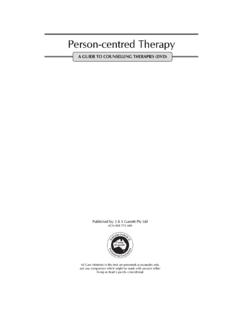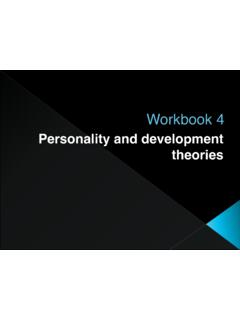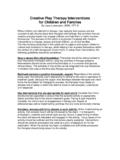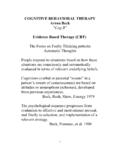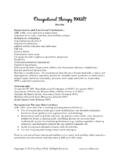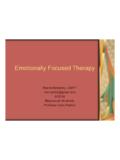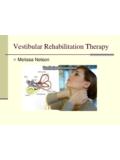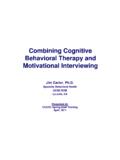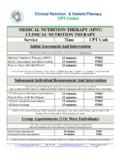Transcription of Person Centred Therapy - Counselling Connection
1 Person - Centred Therapy A GUIDE TO Counselling THERAPIES (DVD). Published by: J & S Garrett Pty Ltd ACN 068 751 440. All Case Histories in this text are presented as examples only and any comparison which might be made with persons either living or dead is purely coincidental Person - Centred Therapy A GUIDE TO Counselling THERAPIES (DVD). CONTENTS. HISTORY .. 3. KEY 3. GENERAL IDEAS ABOUT PERSONALITY 4. THERAPEUTIC TECHNIQUES & METHODS OF WORKING .. 5. 7. STRENGTHS AND WEAKNESSES .. 8. CONCLUSION .. 9. 9. Page 2 of 9. HISTORY. The Person - Centred approach was developed from the concepts of humanistic psychology. The humanistic approach views people as capable and autonomous, with the ability to resolve their difficulties, realize their potential, and change their lives in positive ways (Seligman, 2006).
2 Carl Rogers (a major contributor of the client- Centred approach) emphasized the humanistic perspective as well as ensuring therapeutic relationships with clients promote self- esteem, authenticity and actualisation in their life, and help them to use their strengths (Seligman, 2006). The Person - Centred approach was originally focused on the client being in charge of the Therapy which led to the client developing a greater understanding of self, self-exploration, and improved self-concepts. The focus then shifted to the client's frame of reference and the core conditions required for successful Therapy such as ensuring the therapist demonstrates empathic understanding in a non-judgemental way.
3 Currently, the Person - Centred approach focuses on the client being able to develop a greater understanding of self in an environment which allows the client to resolve his or her own problems without direct intervention by the therapist. The therapist should keep a questioning stance which is open to change as well as demonstrating courage to face the unknown. Rogers also emphasized the attitudes and personal characteristics of the therapist and the quality of the client-therapist relationship as being the determinants for a successful therapeutic process (Corey, 2005). KEY CONCEPTS. The humanistic influence on Person - Centred Therapy As previously mentioned, the humanistic approach has been a major influence on Person - Centred Therapy .
4 Person - Centred therapists believe that clients are capable and trustworthy and they focus on clients' ability to make changes for themselves. Actualisation People have the tendency to work towards self-actualisation. Self-actualisation refers to developing in a complete way. It occurs throughout the lifespan as the individual works Page 3 of 9. towards intrinsic goals, self-realization and fulfilment, involving autonomy and self- regulation (Seligman, 2006). Conditions of worth Conditions of worth influence the way in which a Person 's self-concept is shaped from important people in his or her life. Conditions of worth refer to judgemental and critical messages from important people that influence the way the individual acts and reacts to certain situations.
5 When an individual has conditions of worth imposed on him or her, self- image is often low. Also, if the individual is exposed to overprotective or dominating environments, this can also have a negative impact on self-image (Seligman, 2006). The fully functioning Person The fully functioning Person is an individual who has ideal emotional health (Seligman, 2006). Generally, the fully functioning Person will be open to experience, lives with a sense of meaning and purpose, and trusts in self and others. One of the main goals of Person - Centred Therapy is to work towards becoming fully functioning . Phenomenological perspective The phenomenological approach refers to the unique perception by each individual of his or her own world.
6 The individual experiences and perceives own world and reacts in an individual way. Person - Centred Therapy focuses on the individual's own experience informing how treatment will work. GENERAL IDEAS ABOUT PERSONALITY DEVELOPMENT. There are a number of general ideas about personality development with regard to Person - Centred Therapy . Basically, Person - Centred Therapy states that personality can be fully actualised when the individual is exposed to unconditional positive regard. An individual who has been exposed to conditional positive regard can have low self-esteem and low feelings of worth. An individual who is self-actualised will be more open to experience and less defensive, will learn to live in the moment, will trust own decision-making skills, will have more life choices and be more creative.
7 Page 4 of 9. THERAPEUTIC TECHNIQUES & METHODS OF WORKING. GOALS OF Therapy . The goals of Person - Centred Therapy are (Seligman, 2006): 1. To facilitate client's trust and ability to be in the present moment. This allows the client to be honest in the process without feeling judged by the therapist. 2. To promote client's self-awareness and self-esteem. 3. To empower the client to change. 4. To encourage congruence in the client's behaviour and feelings. 5. To help people to gain the ability to manage their lives and become self-actualised. TECHNIQUES. The techniques employed in Person - Centred Therapy are different from those employed in other therapies. The difference is that other therapies are often focused on something the client can do during the Therapy session, whereas the techniques used in Person - Centred Therapy are employed by the therapist to create an environment that facilitates the process of self-awareness.
8 The following techniques will be discussed in relation to the Person - Centred approach: congruence, unconditional positive regard and acceptance, empathy, and reflection of feelings. Congruence Congruence is whether or not therapists are genuine and authentic in what they say and do. Quite often, if the therapist is saying one thing but the body language is reflective of something else, clients are aware of this and may impact on their trust and openness in the therapeutic relationship (Seligman, 2006). For example, a therapist may say I understand where you are coming from to a client but have a confused look on his or her face. The client can see this confusion and feels uncomfortable with expressing feelings from this point forward.
9 Therefore, a major role of therapists is to be aware of their body language and what they are saying as well as being in the present moment. If confusion arises, the therapist needs to be able to address this with the client. Going back to the previous example of the therapist Page 5 of 9. stating understanding and having a confused look, the therapist notices the client looks uneasy after the comment about understanding and goes on to explain to the client why and how he or she understands the statement. This puts the client at ease and ensures the continuation of trust. Unconditional positive regard Unconditional positive regard refers to the therapist accepting, respecting and caring about clients (Seligman, 2006).
10 It does not mean the therapist has to agree with everything the client says or does, however, the therapist should see the client as doing the best he or she can and demonstrate this by expressing concern rather than disagreeing with him or her. Unconditional positive regard allows clients to express how they are thinking without feeling judged, and help to facilitate the change process by showing they can be accepted. Empathy Empathy is a skill used by Person - Centred therapists to show understanding of the clients emotions. Empathy is different to sympathy in that sympathy is often seen as feeling sorry for the client whereas empathy shows understanding and allows the client to further open up (Seligman, 2006).

